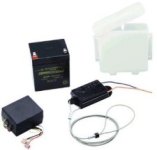Anonymous Poster
Epic Contributor
- Joined
- Sep 27, 2005
- Messages
- 29,678
Gary, I highly recommend installing a battery disconnect switch right at or near the battery. More vehicles burn for the want of a $25- switch than should.
I just had to replace the "automotive type" winch cable running to an electric crane on the back of a truck I bought cause it constantly drew the battery flat sitting overnight.
I just had to replace the "automotive type" winch cable running to an electric crane on the back of a truck I bought cause it constantly drew the battery flat sitting overnight.

